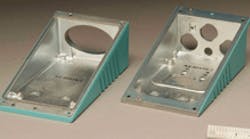| Graphicast Inc., www.graphicast.com |
The optics and electronics for the new machine-vision camera were right on schedule, but the same couldn’t be said for its housing. Such was the dilemma facing Tom Driscol, hardware engineering manager for Siemens’ HawkEye 1600T camera. The two parts of the wedge-shaped housing could not be extruded, leaving the parts to be cast or machined. A die-casting company reported that it would take 14 weeks to manufacture the aluminum castings for the housing. And machining housings from aluminum blocks was out of the question, as each half-shell of the housing would cost about $250 to machine, or $500/case.
With die casting too slow and machining too expensive, Driscol had to find another way to make the camera housing or miss the introduction deadline. The search led to Graphicast, a New Hampshire casting and CNC facility that uses graphite molds to cast parts from ZA-12, a zinc-aluminum alloy that is harder, stronger, and more durable than aluminum, brass, bronze, or plastic. Suitable for production runs of 300 to 20,000 parts, graphite mold casting offered typical turnaround times of four to six weeks from CAD drawing to finished parts.
Early on, Driscol and his team knew the HawkEye would need a durable housing. The new camera’s circuitry generates more heat than earlier models and, therefore, needs a case that can conduct and disperse heat more effectively than the extruded-aluminum housings of earlier cameras. Furthermore, the new camera needed to be industrially hardened and sealed to withstand high ambient temperatures, dust, and humidity, as well as production-line wash downs.
The result of the collaboration between Siemens and Graphicast is a case that keeps out dust, withstands temperatures of 0 to 50°C (32 to 122°F), and is certified watertight despite being submerged for up to 30 min. The housing’s top and bottom halves seal with a single O-ring around the perimeter of the case.
The Graphicast process
The properties of graphite, a form of carbon, prove ideal for moldmaking. Its thermal stability produces a coefficient of expansion lower than steel and its low porosity yields molds that hold their shapes when filled with molten metal. Large runners ensure molten metal fills the mold cavity as the part solidifies, minimizing shrinkage and porosity (air inclusions). Because graphite molds do not warp or corrode, they have an almost infinite shelf life. Also, graphite costs less than tool steel, requires no heat treating, and its machinability shortens the moldmaking phase.
The graphite mold/ZA-12 process yields parts with accuracies and surface finishes better than sand or investment casting at a lower cost per part. Unlike sand and investment casting that destroy the molds when castings are removed, graphite molds are reusable.
As with tool-steel molds, graphite molds are machined in two halves. Graphicast uses a proprietary semiautomated machine that fills the mold from the bottom up. A process controller simultaneously controls fill rate, cycle time, and temperature to maximize casting density and minimize turbulence and porosity.
The attributes of ZA-12 alloy contribute to the casting process. The alloy closely approximates the density of cast iron yet has a melting point of 380 to 430°C (710 to 810°F) that offers good castability at low temperatures. ZA-12 is sparkproof, making it a good choice for hazardous environments, while the nonmagnetic aluminum-zinc alloy shields electronics well.
Tolerances of ±0.003 in./in. for the first inch and ±0.001 in./in. for additional inches are possible directly from the mold. Parts require no heat treating, while typical surface finishes of 63 μin. or less are better than with other casting processes. ZA-12 machines as easily as brass and bronze, and more easily than cast iron and aluminum. Typically, little to no secondary machining is needed.
Although ZA-12 castings have a bright, corrosion-resistant finish that requires no coating or other preparation, weathering turns the surface grey. Chromating or zinc anodizing is recommended for more corrosive environments, but the alloy can also be plated, painted, powder coated, or finished with electrocoated acrylic or epoxy to simulate anodized aluminum.
For Siemens’ runs of 1,000 HawkEye housings per year, Graphicast’s nonrecurring tooling costs were roughly one-fourth the cost of tooling for traditional die-cast aluminum parts. And the cost per housing was only a tenth that of machining the parts from stock.
The final designs for the HawkEye’s housing minimized the number and size of the “gates” — the casting industry term for openings in the mold cavity into which molten metal flows. When the mold opens and the part removed, these hardened channels have to be removed, forming rough areas along the edges of the part. To minimize the need for machining, all of these areas were placed along edges already scheduled to be machined.
Threaded holes for assembly screws and through holes for LED status indicators were added as part of the machining process. A coordinate-measuring machine checked all critical part dimensions for quality control after machining.
Siemens took advantage of Graphicast’s “waived sample” program, so Driscol’s team had its first-article samples, plus 50 more preproduction parts, only four weeks after making the purchase order. The entire process took less than six weeks from plans to parts.
After four months of rigorous testing, the HawkEye 1600T prototypes were ready for production. Only a small change in the masking process around the connector and LED holes during painting was necessary to keep them free of paint.
“We’ve been very happy with the quality of the housings,” says Driscol. “Graphicast really helped get us meet our production schedule and budgets. Our experience validates their key selling point — accelerated time to market.”
